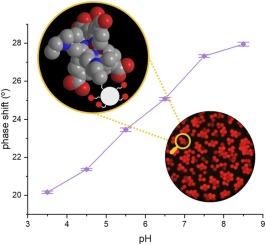利用共价固定的多质子 Ru(II) 复合物进行基于寿命的宽范围 pH 值发光传感
IF 8
1区 化学
Q1 CHEMISTRY, ANALYTICAL
引用次数: 0
摘要
为了克服光学 pH 传感器(其响应仅为指示染料 pKa 值附近约一个 pH 单位)的局限性,并利用红光发光 Ru(II) 复合物在光学传感方面的优势,我们提出了该家族中的多 pKa 成员。含有可质子化基团(胺和羧酸盐)的联吡啶配体是设计和制备指示剂染料的基础。研究了它们在 pH 3.5-9.0 范围内的光物理特性以及对 pH 值变化的响应。复合物[Ru(DCB)2DEAMB](其中 DCB 和 DEAMB 分别代表 2,2'-联吡啶-4,4'-二羧酸盐和 4,4'-(N,N-二乙基氨基甲基)-2,2'-联吡啶)在溶液中的发射波长最大值(648 - 634 nm)、发光强度(1.40 倍)和寿命(335 - 429 ns)随着 pH 值的增加而发生可逆的单调变化。这种复合物和两种类似的复合物被共价地系在商用 TentaGel® M Br 聚合物微珠上,用于发光相移光纤 pH 值测量。固定的[Ru(DCB)2DEAMB]在 pH 3.5 到 pH 8.5 之间显示出最广泛的 pH 灵敏度。在 pH 3.5 至 8.5 之间循环五天,以及在每个 pH 单位之间循环三天,该传感器的稳定性令人满意。缓冲液类型、缓冲液浓度和渗透压的变化对传感器的响应没有显著影响;但是,溶解氧和温度的大幅变化需要相应的传感器进行校正。这种新型、坚固耐用的 pH 值发光传感器已在相敏模式下进行了测试,用于监测商业生物反应器中的细胞培养,但其响应也适用于自然水域的现场监测。本文章由计算机程序翻译,如有差异,请以英文原文为准。

Wide range luminescence lifetime-based pH sensing with covalently immobilized multi-protonatable Ru(II) complexes
To overcome the limitations of optical pH sensors, the response of which is just ca. one pH unit around the pKa value of the indicator dye and capitalize on the advantages of red-luminescent Ru(II) complexes for optical sensing, multi-pKa members of this family are proposed. Bipyridine ligands bearing protonatable groups (amines and carboxylates) are the basis to design and prepare the indicator dyes. Their photophysical properties and response to pH changes were investigated in the pH 3.5 − 9.0 range. The complex [Ru(DCB)2DEAMB], where DCB and DEAMB stand for 2,2’-bipyridine-4,4’-dicarboxylate and 4,4’-(N,N-diethylaminomethyl)-2,2’-bipyridine, respectively, shows a reversible monotonic change of its emission wavelength maximum (648 – 634 nm), luminescence intensity (1.40x) and lifetime (335 – 429 ns) in solution with increasing pH. This complex and two similar ones were covalently tethered to commercial TentaGel® M Br polymer microbeads for luminescence phase shift fiberoptic pH measurements. The immobilized [Ru(DCB)2DEAMB] displays the widest pH sensitivity over pH 3.5 to pH 8.5. The stability of this sensor was satisfactory when cycling between pH 3.5 and 8.5 for five days as well as under a three-day cycle between each pH unit. Changes of the buffer type, buffer concentration and osmolarity did not significantly influence the sensor response; however, large variations of dissolved oxygen and, naturally, temperature would require correction by the corresponding sensors. The novel, robust luminescent pH sensor has been tested in phase-sensitive mode for cell cultures monitoring in commercial bioreactors, but its response would also be suitable for in situ monitoring of natural waters.
求助全文
通过发布文献求助,成功后即可免费获取论文全文。
去求助
来源期刊

Sensors and Actuators B: Chemical
工程技术-电化学
CiteScore
14.60
自引率
11.90%
发文量
1776
审稿时长
3.2 months
期刊介绍:
Sensors & Actuators, B: Chemical is an international journal focused on the research and development of chemical transducers. It covers chemical sensors and biosensors, chemical actuators, and analytical microsystems. The journal is interdisciplinary, aiming to publish original works showcasing substantial advancements beyond the current state of the art in these fields, with practical applicability to solving meaningful analytical problems. Review articles are accepted by invitation from an Editor of the journal.
 求助内容:
求助内容: 应助结果提醒方式:
应助结果提醒方式:


